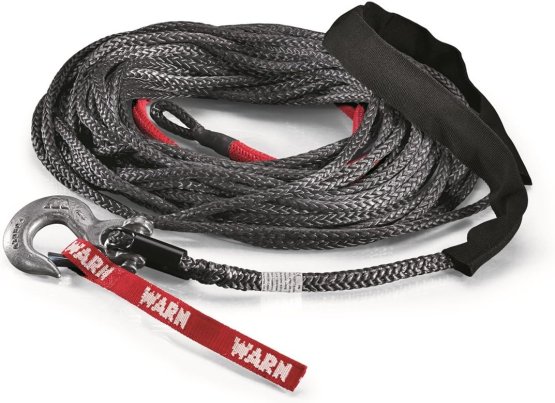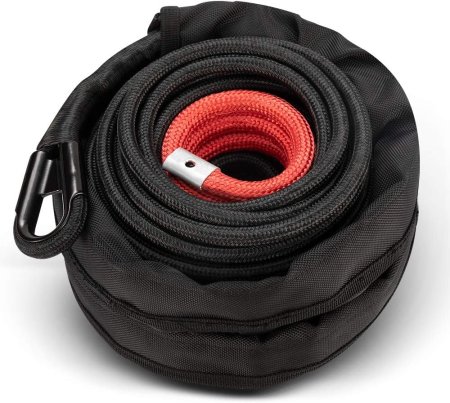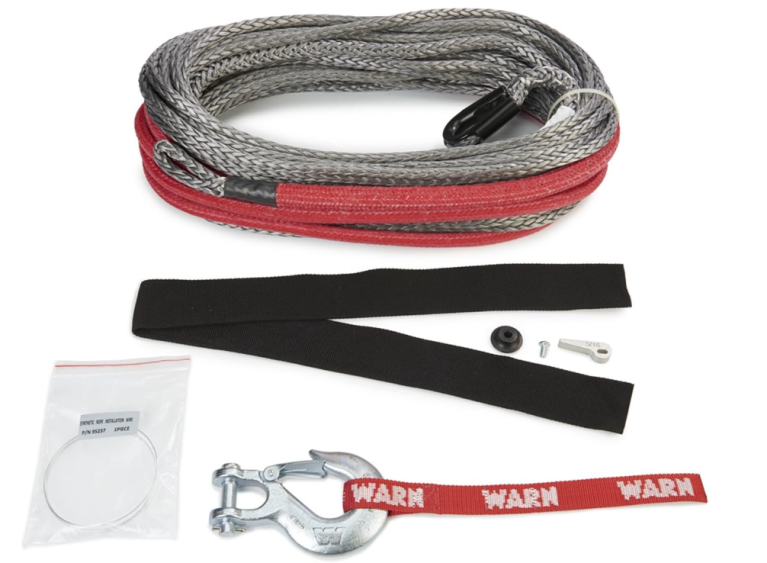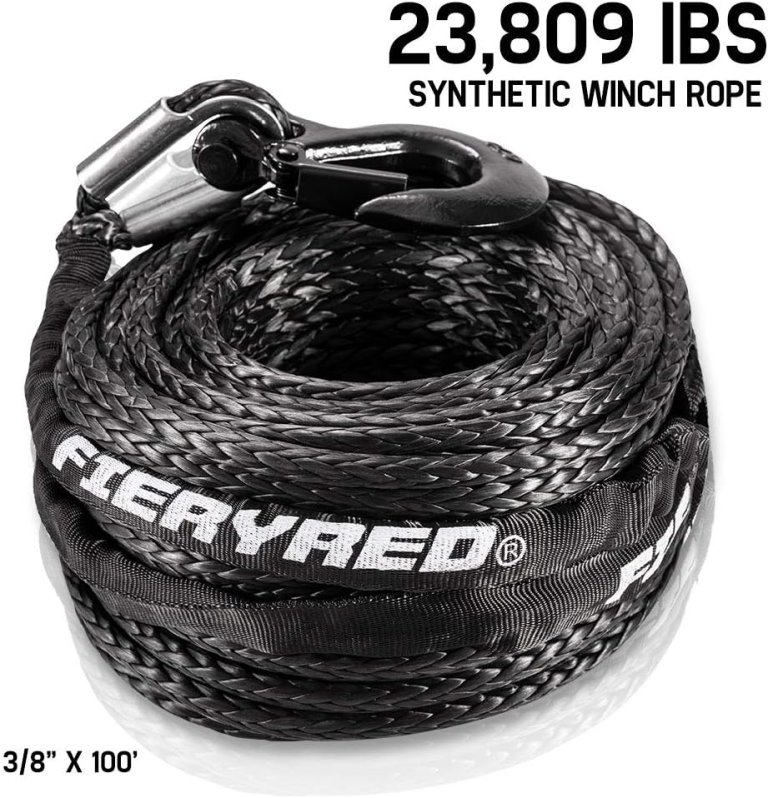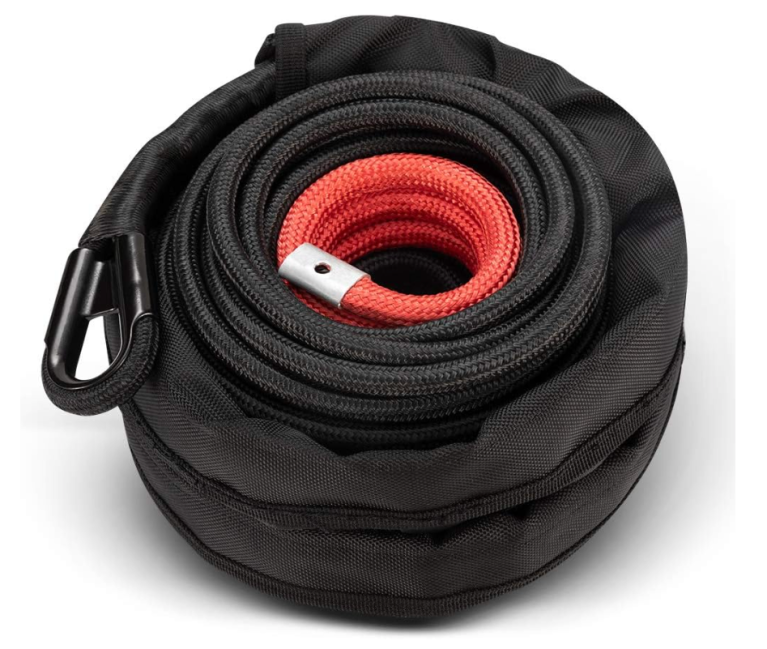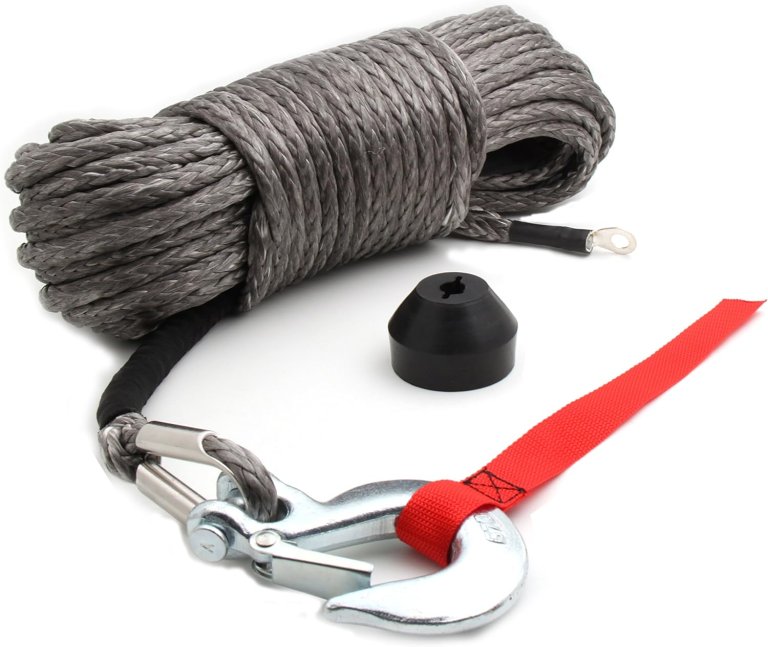We may earn revenue from the products available on this page and participate in affiliate programs. Learn more ›
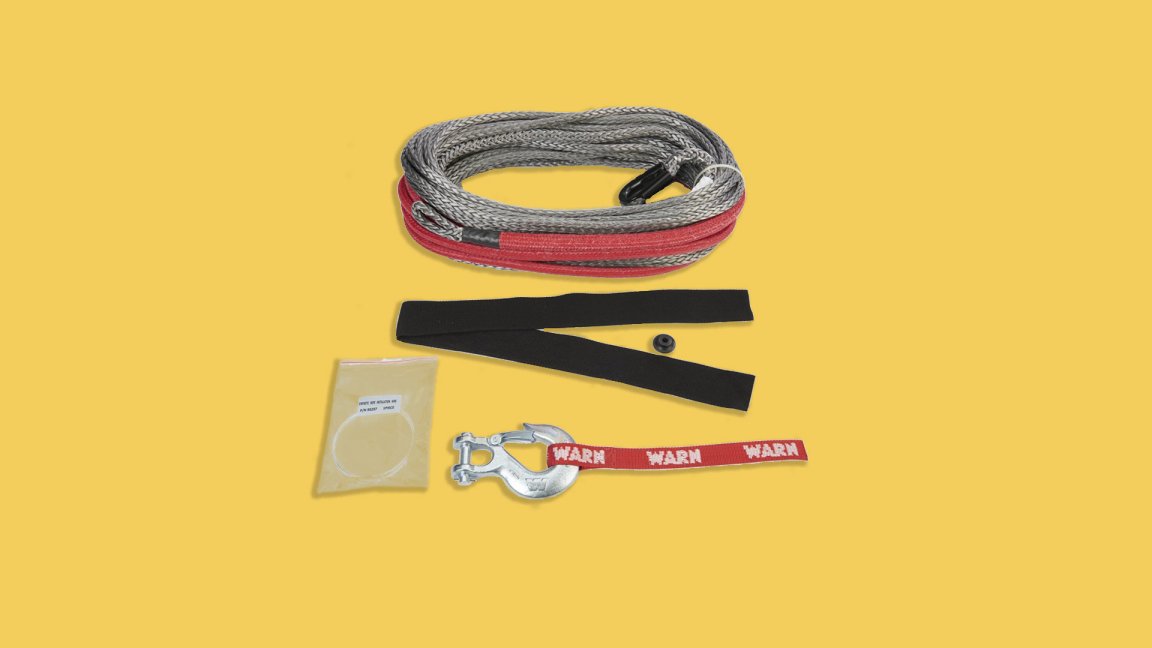
We’ve covered quite a few topics when it comes to vehicle recovery here at The Drive — from traction boards to come-alongs to winches. Adding a winch to your off-road or overland setup is definitely a big investment, but a winch can completely change the game for your vehicle recovery capabilities. A good winch paired with the training to use it correctly and safely will open the door to more challenging and technical trails. Replacing your old steel winch line with a synthetic winch rope adds additional capability, safety, and new recovery techniques — all while reducing weight.
A winch offers a particular peace of mind that few other recovery aids can. And, while you will find that you might rarely use it; when you do find yourself in a situation where you need that winch, you really need it.
This humble tool has been around since the days of ancient Greece. While the mechanics behind the winch have remained mostly the same over the millennia, 21st-century technology is making the winch more user-friendly and versatile than ever. Synthetic winch rope is a top upgrade, but there are lots of choices out there, and some important variables to consider when choosing a synthetic cable. The Drive is here to throw you a line.
A winch offers a particular peace of mind that few other recovery aids can. And, while you will find that you might rarely use it; when you do find yourself in a situation where you need that winch, you really need it.
Summary List
- Best Overall: WARN Spydura Pro Synthetic Winch Cable Rope
- Best Value: FIERYRED Synthetic Winch Rope Cable Kit 3/8inch
- Honorable Mention: Bunker Indust Synthetic Winch Rope
- Best For UTV: Offroading Gear Heavy-Duty Synthetic Winch Rope Kit
Our Methodology
I’ve used winches for vehicle recovery on two different continents, with very different vehicles, and in a variety of terrain. In almost all instances, I’ve preferred synthetic winch rope to the traditional steel line versions. While I can’t spool my winch with every length of rope in this review, I’ll lean on my own recovery experience in the field, as well as expert advice and consumer reviews to evaluate the products I’m featuring.
As always, The Drive strives for transparency and accountability in all of our product evaluations, and we directly disclose our affiliate links when you click through to one of these winch lines. Make sure you check out our review policies here.
Best Synthetic Winch Ropes: Reviews And Recomendations
Best Overall: WARN Spydura Pro Synthetic Winch Cable Rope
If you’re off-roading in an exceptionally large vehicle, the rating of your winch is extremely important. If you’re “under-winched” you’ll be looking at a potential recovery disaster if it fails. For heavier rigs, a synthetic winch line is perfect for a few reasons. Winching forces increase exponentially the more weight is brought to bear on the system.
Synthetic rope is generally stronger than traditional steel line, and, should it break, snap-back is all but eliminated vis-à-vis metal rope. It’s simply a safer alternative. So, despite the heavy hit to your wallet, the Warn Pro Synthetic line is a clear choice for heavier vehicles.
Best Value: FIERYRED Synthetic Winch Rope Cable Kit 3/8inch
The Fireyred synthetic winch line is one of Amazon’s top sellers, and its price point is a big reason why. With a remarkable weight to strength ratio, this 100-foot synthetic rope will immediately increase the versatility of your winch while shaving pounds off the front of any truck.
Layered with a high-tech coating that fights moisture, chemical contaminants, and UV rays, the Fieryred rope should stay protected while it lives in the harsh conditions under your bumper. The eye-popping 23,000-pound weight capacity is impressive, but check the capacity of your winch before trying to use your Tacoma to yank that Unimog out of the bog.
Honorable Mention: Bunker Indust Synthetic Winch Rope
This winch rope from Bunker Indust is another great value option. It’s a 3/8-inch line that’s 85-feet in length that includes a removable heat guard. The line is rated at 26,000 pounds. The line itself is 4.2-pounds, so it’s easy enough to transport and load.
This is a good bargain, but not be the most durable rope available. Some offroad users have reported fraying in the first year, while a couple of flatbed operators claim it’s been bulletproof. So your mileage may vary depending on use.
Best For UTV: Offroading Gear Heavy-Duty Synthetic Winch Rope Kit
Small vehicles get stuck too! The off-road capabilities of UTVs, ATVs, and side-by-sides has increased significantly in recent years as manufacturers have introduced new models designed specifically for tackling tougher trails. Many of those UTVs come equipped with a winch straight from the factory.
Useful for work around the farm or ranch, as well as for recovery, a lightweight winch rope makes a lot of sense. Offroading Gear’s synthetic winch rope kit comes with a carrying bag, steel snap hook, and rubber shackle stopper to round out the upgrade. It’s a killer deal, too.
Our Verdict on Synthetic Winch Ropes
Winching is an inherently dangerous activity, and synthetic winch line lessens the hazards significantly. Warn Spydura winch line, while more expensive than most of the others on the market, has proven to be durable, ultra-strong, and easy to use. For me, the icing on the cake is Warn’s impressive limited lifetime warranty for its synthetic winch lines. They stand by the product.
What to Consider When Buying Synthetic Winch Line
Why upgrade your winch line to synthetic when your old steel line seems to work just fine? In my experience, the number one reason is the increase in safety. You can get more creative and effective with your recovery tactics without increasing the risk to your vehicle or yourself. Let’s look at how the two types of winch line stack up.
Types of Winch Line
Steel Winch Line
One area of winch design that has made big leaps in recent years is in the winch line itself. High tensile steel cable has been the standard winch rope for decades, and while it is extremely robust and durable, there are a few drawbacks.
Steel cable is heavy, and that weight penalty may be particularly hard felt if you don’t use your winch all that often. Lugging around that extra mass way out front on your bumper definitely isn’t helping your fuel economy, and it can put some extra strain on your suspension and braking components. Steel cable can corrode over time, and sharp strands that come loose from the winding can be a safety hazard for your hands. While extremely rare, when a steel winch line fails under heavy loads, all that mass can make for an extremely dangerous situation. The kinetic energy stored in the rope is significant, and a sudden failure leads to an extremely powerful snapback — search for some YouTube videos of steel winch line failure and you’ll see what I’m talking about.
Even with all these drawbacks to steel winch rope, for most of the recent history of the winch, there wasn’t much off-road explorers could do about it. Nothing could match the strength and longevity of steel line. That is until synthetic winch rope hit the market.
Synthetic Winch Line
Made from high strength and abrasion resistant nylons and polyethylene, synthetic winch line is quickly becoming the standard for most modern winch setups. With weight savings of up to 20 pounds over comparable steel lines, the lower mass of synthetic winch line means not only less weight for your vehicle to carry around but also safer and more convenient winching. No more lugging steel cables to winch points, no more flying rope in the event of a failure. Synthetic line is more flexible as well, so you can get really creative with your recovery techniques. Winding and unwinding your synthetic line from the winch’s drum is nearly effortless.
As with any wound rope, synthetic winch line does require a bit more maintenance to ensure that it remains durable and long-lasting. And, there are some accessories, such as soft shackles and fairleads, which are specific to winches equipped with synthetic lines. But, the added versatility and safety of synthetic lines make it worth upgrading the rest of your recovery toolbox.
Synthetic Winch Line Key Features
Synthetic Winch Line Capacity
In general, there are two basic ways to measure the strength of a synthetic winch rope. First, there is breaking strength. This measures the weight at which a particular winch line will reach its pulling capacity and actually snap. Take, for example, the Fireyred synthetic winch line. Its breaking capacity is over 23,000 pounds, which is a shockingly high number – stress almost nobody would ever put on a winch line in normal conditions. In some ways, this measurement isn’t that useful for understanding a winch line’s capabilities.
The second way to consider a winch line’s weight capacity is related to the winch itself. If your winch is only rated to pull 10,000 pounds, then a breaking strength of 23,000 pounds for your winch line isn’t really relevant. You should match any synthetic winch line you buy to the capacity of your winch. Installing an 18,000-pound capacity line on a 10,000-pound winch doesn’t make much sense, and doing the opposite is a recipe for disaster.
Synthetic Winch Line Material
Nearly all synthetic winch rope is made of multiple strands of polyethylene material woven together to create a strong, yet flexible and lightweight line. Since the materials are largely the same, what do you look for in the construction of a synthetic winch line? Two factors are important: the density of the weave and the quality of the coating.
The more compact and dense the weave of the rope, the longer it will last. A compact weave prevents moisture and abrasive materials like sand and dirt from penetrating the line itself. Over time, trapped abrasives can wear out a synthetic winch rope from the inside, diminishing its life and capacity. A good synthetic winch line should also have a urethane or polyurethane coating to repel water, chemicals, and UV rays — all of which can damage the line. The coating will also make handling the rope, as well as spooling and unspooling it, much easier.
Shackles and Hooks
A synthetic winch rope is only as good as what’s installed at the end of it. There are a few approaches to connecting a winch line to a vehicle or an anchor point for a recovery effort. The most common is the snap hook — strong and easy to use, the snap hook is also generally the strongest connector. Look for hooks that are removable, made from rust-resistant galvanized steel, and include a high-visibility cloth tab for safety. Many synthetic winch ropes are built with an embedded steel eye loop. You can attach a wide range of connectors to the eye, including hooks, steel shackles, soft shackles, or “flat link” shackles. I prefer a winch line with no installed connector at all — just a loop of the winch line material itself at the end. It’s the most versatile solution for many recovery situations.
Synthetic Winch Line Pricing
Like many off-road-oriented products, pricing on synthetic winch lines can be all over the map. Less expensive lines, like our Best Value pick, the Fieryred, and the Honorable Mention winner, the rope from Bunker Indust, are likely not to experience catastrophic failure in comparison to more expensive winch ropes. However, they may require more frequent inspection, more careful maintenance, and can experience a shorter service life.
FAQs
You’ve got questions. The Drive has answers!
A: Yes! Synthetic winch rope requires regular cleaning and maintenance that traditional steel line does not. It’s worth it for the weight savings and increase in safety, though. See how easy it is as explained by expert overlander Tim Huber: https://www.youtube.com/watch?v=wvgZrhnjAHc.
A: The fairlead is the opening through which your winch line exits the winch spool. Synthetic winch line requires either an anodized aluminum fairlead, or a fairlead with enclosed rollers to prevent pinches and binding that can damage the line.
A: Yes! While many winches now come equipped with synthetic rope straight from the factory, you can replace the steel line in your current winch with synthetic. Just make sure you buy the correct length, diameter, and weight rating to replace the old line.
